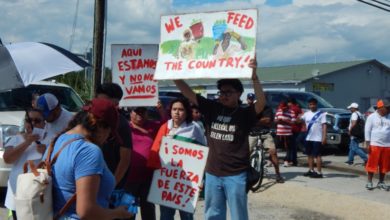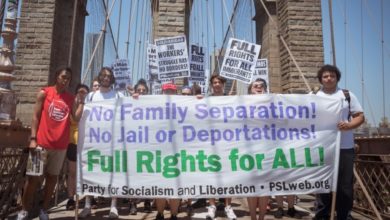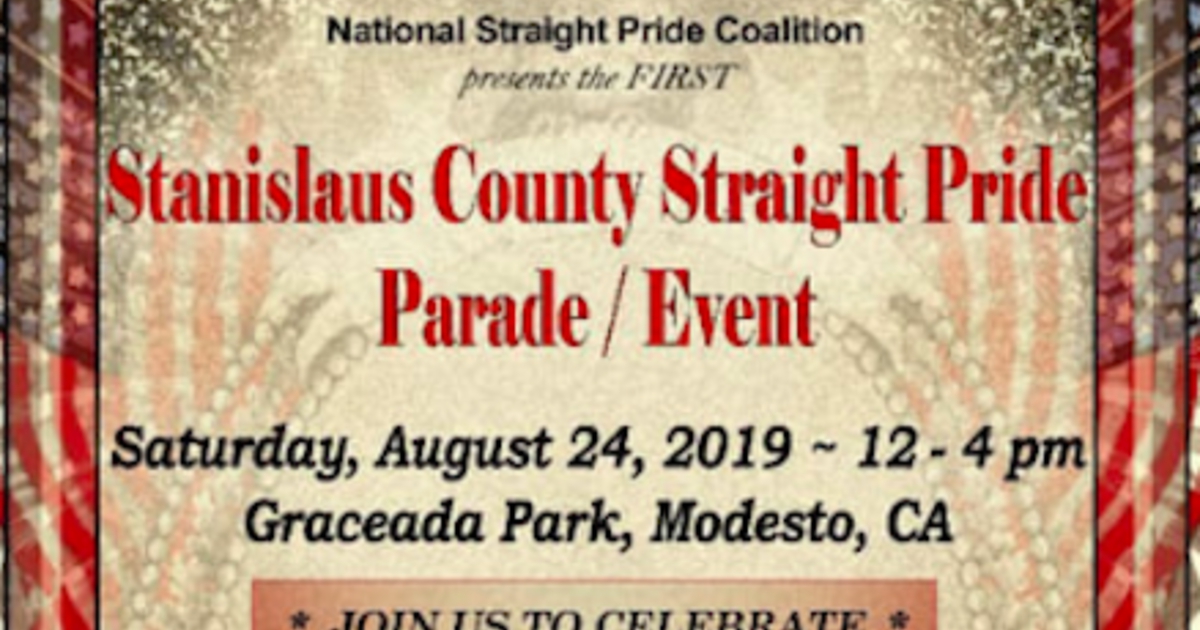Over the last five months, many new young leaders have risen up against police brutality, murder and racism, in the names of Michael Brown, Eric Garner, Tamir Rice and many others. The Twitter hashtag #blacklivesmatter has been voted “the word of 2014” by the American Dialect Society.
As new young leaders continue the struggle against state racism and police terror, it can be helpful to reflect on a not-so-distant immigrant rights struggle that took place about nine years ago.
On Dec. 16, 2005, the racist, anti-immigrant “Sensenbrenner” bill (the Border Protection, Anti-terrorism and Illegal Immigration Control Act, HR-4437), passed in the House of Representatives. The bill was a real threat to all undocumented people and their families. If the racist bill had become law, approximately 12 million undocumented workers and their families would have been subject to arrest on felony charges, simply for living and working in the United States. The law would have converted immigration violations to felonies rather than civil offenses. This would have been another escalation of the war on immigrants. It also provided additional money for work site and border raids.
A huge mass movement arose quickly throughout the United States demanding full rights for undocumented workers. “Amnesty Now!” was the main demand on the streets.
The protests involved millions of people and included marches and rallies in cities across the country. High school and middle school students played a significant role in the organizing, through walkouts, hunger strikes and community organizing. Online organizing spread the people’s message of amnesty, and forced the larger, well-funded immigrant rights groups to listen.
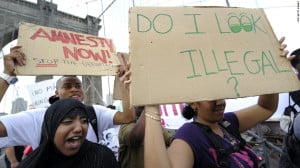
Ultimately, the Sensenbrenner bill was defeated. More recently, the movement made significant gains with the Nov. 20, 2014, executive action expanding protection from deportation to 4 to 5 million undocumented residents.
After the 2006 struggle, it took six more years for President Obama to announce protection from deportation, the Deferred Action for Childhood Arrivals program. It took another two and a half years for him to take executive action again. Congress still has not passed any wide reaching immigration reform, and family separations continue.
Here are five lessons from this struggle that still apply today:
(1) The movement brought out millions of workers into the streets to demand change.
In the first major action to attract national attention, on March 10, 2006, hundreds of thousands of people marched in Chicago. Undocumented communities organized themselves to protect people from deportation and arrest and encouraged families to take to the streets whether they had papers or not.
Following the Chicago demonstrations, millions of people rallied and marched in protests in various cities. On March 25, over 500,000 protesters marched through downtown Los Angeles. Thousands of marches continued from March through May 2006. Another major day of demonstrations occurred on April 10, with protests in Atlanta and Washington, D.C.
On May 1, 2006, the largest demonstrations ever in U.S. history took place around the country. Millions of people took part in nationwide marches in Chicago, Los Angeles, New York, Denver, San José, Phoenix, Milwaukee, New Orleans, Las Vegas and nearly 50 other cities. With millions of undocumented workers absent from work, whole industries had to shut down, including giant food-production plants, restaurants and stores.
(2) Youth organizing spread the message, brought new tactics.
Youth played front and center leadership roles in the 2006 immigrant rights struggle. In the Chicago March action, hundreds of students from high schools around the city did not attend school in order to join and support the rally.
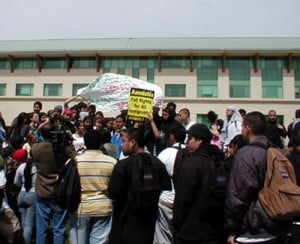
On March 27, 2006, students from high schools and middle schools around the country collectively walked out of their schools in protest. Over 40,000 students participated in the walkouts in the Los Angeles area alone. In each city, students would march to other area schools to rally more students to join the protests. The walkouts were influenced by the 1968 Chicano student walkouts in East Los Angeles, about which an HBO film, “Walkout,” was released in mid-March 2006.
The students organized themselves using cell phones and social media to spread plans. They communicated about the walkouts through text messages, e-mail, Facebook and MySpace. Walkouts continued through April.
Many school districts, including the Los Angeles Unified School District, however, did not support their students. They responded by putting their schools on lockdown. The LAUSD further required students to stay after school, subjecting them to anti-walkout and anti-immigration reform propaganda. They called the police to arrest students and issue truancy citations, violently using pepper-spray and handcuffs. Some schools also threatened official disciplinary action, such as suspensions and expulsions.
Despite these crackdowns, students continued to organize themselves and leave schools, defying the lockdowns, to hold more walkouts.
(3) An organized, widespread general strike of workers can bring society to a halt and show our power.
One reason for the success of the huge May 1, 2006, protests is that they were organized as a national general strike. The protests launched a nationwide boycott, known as the Great American Boycott, or A Day Without an Immigrant. Undocumented immigrants boycotted schools and businesses and did not attend work. Over 1 million protesters marched in Los Angeles alone.
One popular slogan, “The sleeping giant has awoken,” referred to the collective power of immigrant workers and their families. This is the power that stopped the Sensenbrenner bill from passing in the Senate.
(4) The Democratic Party redirected organizing toward the elections to maintain the status quo and its political relevance.
In response to the power of this mass movement of undocumented immigrants and their families, the terrified ruling class jumped into action, devising policies aimed both at pacifying the masses and protecting corporate profits. Some sectors of the immigrant rights movement who themselves were funded by Democratic Party institutions did not support the general strike organizing. The National Capital Immigration Coalition in Washington, D.C., for example, urged workers and students not to leave their jobs and schools on May 1.
In 2006, these voices lost to the more militant demands of immigrant communities protesting nationwide. The Democrats seemed unable to meet the movement’s demands. Even an incomplete immigration reform bill failed that year in the Senate, and the demands for amnesty were not fulfilled.
The Democratic Party needed more seats in Congress and saw the 2006 election as its opportunity to offer the movement a promise of future reform. The protesters were told that a sweeping reform was impossible without a Democratic majority in Congress. The demonstrations subsided in favor of efforts to organize for congressional and later presidential elections.
Despite this compromise, immigration raids intensified, including the Agriprocessors raid in Postville, Iowa, on May 12, 2008. Postville was the single largest immigration raid in U.S. history—with approximately 400 immigrant workers arrested.
Nine years later, including at least two years of a Democratic super-majority, the Democrats still have not brought sweeping reform. They have presided over the largest deportation apparatus in history. President Obama has used “deferred action” or protection from deportation as a bargaining chip against the Republicans and as a carrot for immigrant support. It has not solved the problem of deportations. It has not committed to solving the problem of deportations. It has granted significant concessions, like deferred action, only after prolonged and determined struggle.
We will no doubt be told that if we do not elect more Democrats to the White House and Congress, sweeping immigration reform will again be impossible. What we really need is an independent mass struggle committed to ending the system of deportations, even if that requires political independence from the Democratic Party and the non-profit organizations that it funds.
(5) The more broad-based the struggle, the more widespread the victory.
The 2006 general strike succeeded in defeating Sensenbrenner and flexing the might of organized Latino and immigrant working-class communities in the United States, but it did not win immigration reform or end the oppression of immigrants. Before 2006, the labor union movement, for example, had not played particular attention to immigration issues, but the general strike caused things to change.
One possible reason that sweeping immigration reform did not pass in 2006 is that the immigrant rights movement had not yet captured other sectors of society. Most protesters were Latino, and the Democratic and Republican parties were able to leverage their support in other communities to limit their concessions to the movement. After May 1, the ruling class was able to resume business as usual. Immigrant rights demands did not expand into labor rights or anti-poverty demands, or more.
A movement of millions of workers is powerful, but a movement of tens of millions—or even more—is unstoppable. In our current anti-racism struggle, organizing as broadly as possible will not only allow the movement to grow in numbers and experience, but it will continue to change American culture from one that encourages passivity to one that fosters protest and progress.




